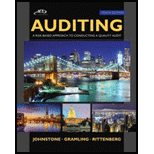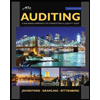
Concept explainers
Introduction: The concept ofmateriality is where small transaction or amount matters that can change the decision of the users. Materiality misstatement concept includes omissions that are considered as material. They effect the financial decisions of the users.
To Select: State whether the given condition is true or false.
Answer to Problem 1TFQ
The given statement isfalse.
Explanation of Solution
The given statement states that the auditor bases materiality solely on quantitative factors but this is not true as auditor focuses onboth the factors for materiality such as quantitative and qualitative. Identification and material misstatements assess the standard that is requiredby the auditor in the financial statements through understanding the client’s environment, related areas, and internal control.
Want to see more full solutions like this?
 Auditing: A Risk Based-Approach (MindTap Course L...AccountingISBN:9781337619455Author:Karla M Johnstone, Audrey A. Gramling, Larry E. RittenbergPublisher:Cengage Learning
Auditing: A Risk Based-Approach (MindTap Course L...AccountingISBN:9781337619455Author:Karla M Johnstone, Audrey A. Gramling, Larry E. RittenbergPublisher:Cengage Learning Auditing: A Risk Based-Approach to Conducting a Q...AccountingISBN:9781305080577Author:Karla M Johnstone, Audrey A. Gramling, Larry E. RittenbergPublisher:South-Western College Pub
Auditing: A Risk Based-Approach to Conducting a Q...AccountingISBN:9781305080577Author:Karla M Johnstone, Audrey A. Gramling, Larry E. RittenbergPublisher:South-Western College Pub

